Discovery of the Rotunda
In December 2003, when the Lesser Town building of the Faculty of Mathematics and Physics CU was being reconstructed, the removal of backfill in the walled-up space under a room on the first floor was started with the intention of creating a new study in its place. A complication arose when masonry blocks originally identified by conservationists as Baroque cellars started to surface. But when no entrances to the assumed cellars were discovered, it became clear that the objects in question were crypts.
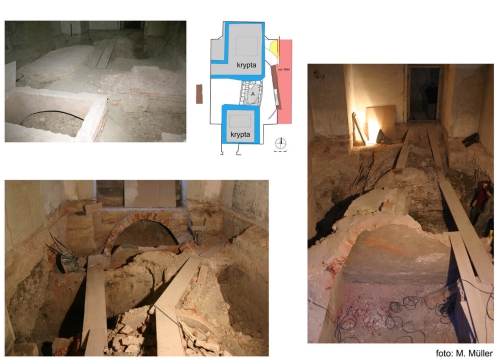
Archaeological research running parallel to the construction work was standard conservation research, similar to that commonly carried out every year. It started in late 2003, along with backfill removal from the space under the floor of a former church situated on the first-floor level of the Lesser Town building that currently houses FMP CU. The builders demolished the walls and cleared the wreckage, while the archaeologists documented the composition of the debris, searching it for findings and surveyed the walls layout. On February 3, 2004, when the diggers reached the bottom of the detritus, circular masonry at the Rotunda’s foundation revealed itself, which put all construction work to an immediate end. A month later, original Romanesque tiles were discovered in situ and the Faculty’s initial intention started taking a completely different direction.
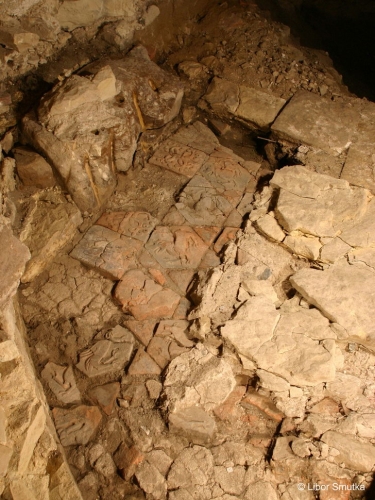
After a number of interruptions of varying lengths designated for the implementation of other conservation research projects, the research on the Rotunda was completed in September 2005; divided into several phases, it lasted for ten months. There was much more to be discovered still, but could not at the moment for lack of financial resources.
Ten years passed before the archaeologists could continue with their research. Math-Phys finally saw an opportunity in the EEA Grants from Iceland, Lichtenstein, and Norway competition. A team led by the vice-dean Dr. Martin Vlach then had to wait for almost a year to hear the final decision. The total of 209 project proposals entered the competition out of which only 26 were successful. Among them was the Preservation Project for St. Wenceslas Rotunda at 25 Lesser Town Square. The Project was symbolically begun on New Year’s Day 2015. The sum of ca. 8 million CZK was supplied by the EEA Grants, and the Faculty made a commitment to provide an additional sum of at least 2 million CZK. In the course of the Project’s implementation, an online application for donations called “Our Rotunda” was launched and, with the help of various media, it eventually attracted over 800 donors.
The archaeologists were finally able to return to their work on the Rotunda. And they did not come back alone. Restorers and companies were invited to join the Project and participate in the reconstruction of this exceptional building. The Rotunda then witnessed mortar, masonry, and flooring analyses, geochemical analyses of terrains and samples, radiocarbon 14C analyses, analyses of material findings and a geological report. The restorers’ tasks included carrying out the restoration of the walls and tiles, manufacturing and laying of the replica of the tiling, and deciding on credible wall coloration. Construction companies secured the adjustments of the entrance area. Steps and a footbridge were built, wiring and lighting were secured, and special ventilation equipment was installed. For almost two years the Rotunda was literally inhabited.
And the result? On September 28, 2016, the Czech Statehood Day, the Rotunda was reopened after almost 400 years. It has lived to see the miracle behind which lay the work of tens, or even hundreds of people, to whom our immense thanks are due.
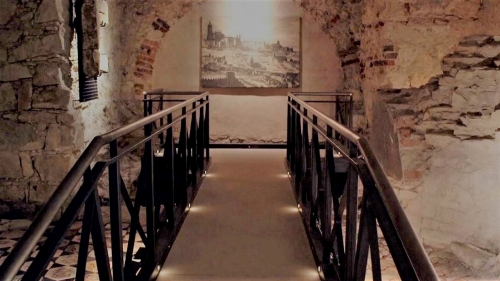
Findings in the rotunda
The space occupied by the rotunda is a relatively small discovery site. The archaeologists were therefore surprised by the number and diversity of the findings that lay hidden in its depths. Among the things documented was a jewellery collection dating back to the 9th and 10th centuries, six skeletons belonging to a knight’s family from the era of John of Bohemia and more than 3,000 pottery fragments. Of significance was also the discovery of parts of different buildings. All these have elevated the rotunda which was undiscovered by experts until only recently to the status of one of the most significant archaeological sites in Prague.
Immovable findings
Historic sights of many eras have been discovered under layers of soil and sediment. Among the oldest is the shallow flat bottom and wooden threads composed of timbered corner logs. Further research has also uncovered a hearth and a tank. Everything seems to indicate that a house stood here already by the end of the 8th century. Therefore, at the very beginning of its history, the rotunda most likely did not have a spiritual function as is also suggested by the Wenceslavian legend Oriente iam sole from mid-13th century. Around the year 900, however, the location was transformed after the house burned down during a war attack. This event is evidenced by two arrowheads discovered here.
The large number of formal alterations which the space of the future rotunda endured in the course of the 9th and 10th centuries was a major surprise for the archaeologists. Another building from which only a wooden beam has survived succeeded the house. Underneath this beam, however, a skeleton of a new-born has been found, which allows us to speculate that already in the first half of the 10th century the place was associated with spiritual tradition. This assumption is also supported by the presence of a circular structure composed of flat marlstone slabs.
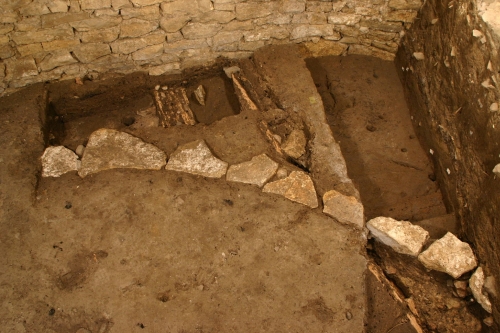
The archaeologists were long puzzled by the stone circle before they arrived at the conclusion that it was most probably a remnant of the oldest stone building of sacral purpose dating back to the second half of the 10th century. It is therefore most probably the first Christian church that stood at this place and the oldest church outside Prague Castle.
St Wenceslas Rotunda was most probably erected here in the last quarter of the 11th century. This dating is supported by the discovery of the unique Romanesque tiling found in situ (see picture). Only the nave of this building has been preserved, its apse having disappeared in the course of the 17th century.
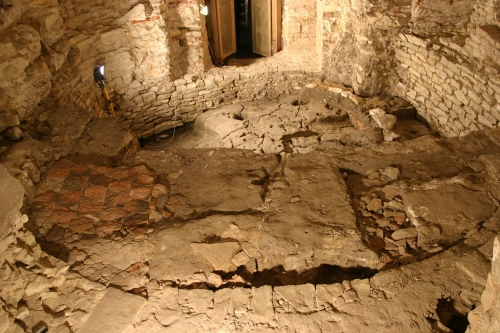
Movable findings
Compared with the conventional early-medieval buildings of the Lesser Town, a fairly high amount of movable findings has been acquired during the research on St. Wenceslas Rotunda. One of the reasons for this is the fact that important spiritual sites were located in this area. The variety of the findings is extraordinary. Ceramic fragments complemented by numerous animal bones form the core of these findings. Among several remarkable findings is a set of iron objects. Another exceptional finding is a brass-decorated key to a spring bolt lock discovered in a sediment layer from the time of King Ottokar II of Bohemia, which originated when the new tiling was laid after the second half of the 13th century.
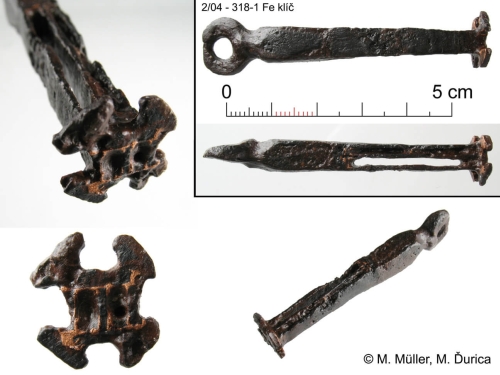
A relatively rare finding is the arrowhead linked to Hungarian raids. The arrow comes from the burnt site of the wooden house from around the year 900.
The unusual iron object is most likely a small file. High in importance among the discovered set of iron objects is also a little, centimetre-long button with an eyelet made of bronze-and-lead alloy, dating back to the time around mid-10th century. Findings of this kind are absolutely exceptional for the Bohemian region.
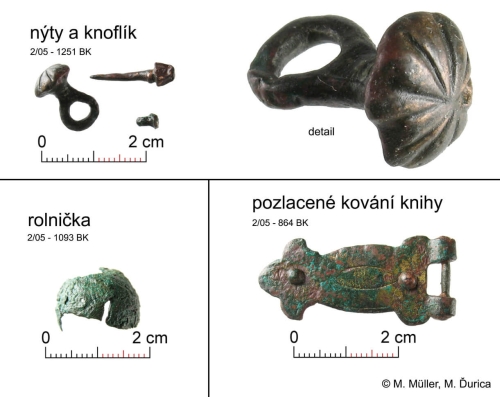
Bone artefacts were used as awls, needles or ornaments.
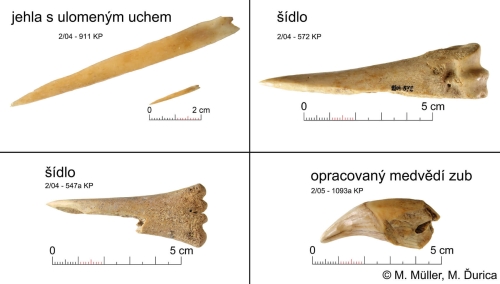
Another interesting finding is an object reminiscent of a razor blade. It could have been used by the men of elite, commonly portrayed in period paintings with a beardless face.
Among the smallest discovered objects are green glass beads from either a necklace or an applique.
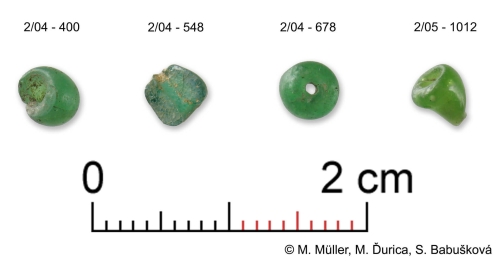
Anthropological findings
The unique Romanesque tiling found in the nave suggests that when the rotunda was constructed in the 11th century, it was not in order to serve as a burial place. Yet the research on site revealed six tombs. Those found in the southern nave most likely belong to a single family – a man with a war wound (healed wounds on the skull) and what are likely his children. The family was buried here during the reign of John of Bohemia and it is very probable that it was the family of a member of the King’s entourage. Another tomb was found close to the northern wall of the nave. Underneath base beam remains, a little pit containing a new-born’s skeleton was discovered
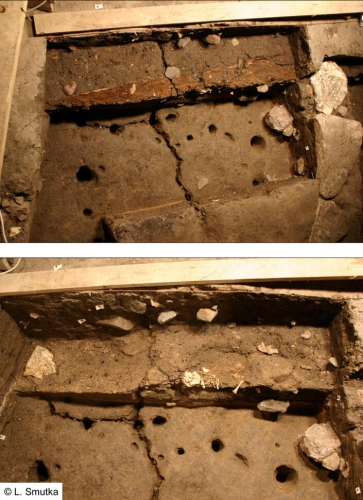
Several High Gothic tiles were found in the layer of soil covering the skeleton featuring the coat of arms of bishop John IV of Dražice.
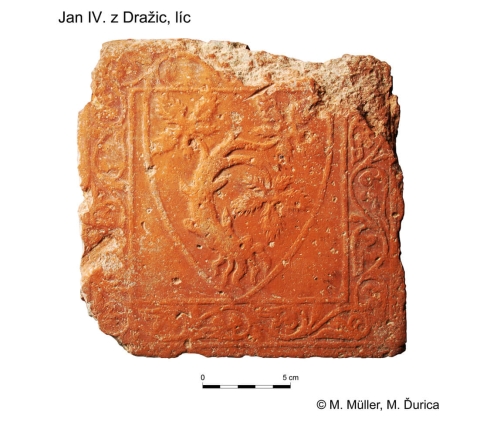
The reason for this can only be guessed at. Such a low number of burials in the nave of the Romanesque church is surprising, but what is even more striking is the absence of tombs around the rotunda. In its vicinity (during the research carried out in the ground-floor corridor to the depth of 0,5 meters) no tombs were found. At least in the Romance period burials did not take place in the area around the rotunda. No tombs were discovered dating to the High Middle Ages, when the historical materials already mention the presence of a nearby cemetery.